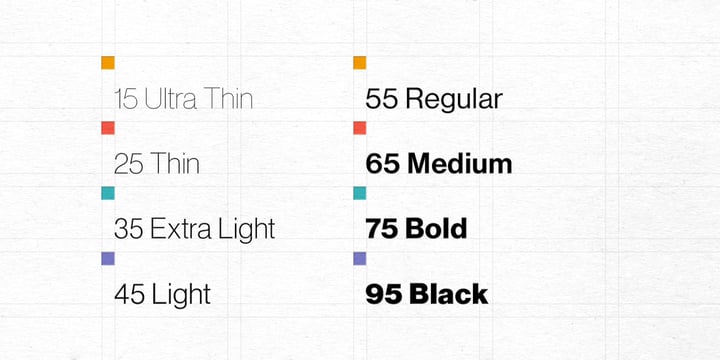

^ This feature was also included in Robert Slimbach's neogrotesque Acumin (2014) for Adobe.^ 'Antique' is a term used in French for sans-serifs (for instance Antique Olive), although in English it traditionally historically referred to slab-serifs.Larabie has also taken inspiration from Helvetica in some of his other designs, including Movatif and GGX88. As of 2017, the semi-bold remains Larabie's most popular font. Larabie's company Typodermic offers Coolvetica in a wide variety of weights as a commercial release, with the semi-bold as freeware taster. The most widely known and distributed of these is Coolvetica, which Larabie introduced in 1999 Larabie stated he was inspired by Helvetica Flair, Chalet, and similar variants in creating some of Coolvetica's distinguishing glyphs (most strikingly a swash on capital 'G', lowercase 'y' based on the letterforms of 'g' and 'u,' and a fully curled lowercase t'), and chose to use set a tight default spacing optimised for use in display type. In the digital period, Canadian type designer Ray Larabie has released several digital fonts based upon Helvetica. The Q glyph in Helvetica has a straight cross mark, while the cross mark in Arial has a slight curve.

The number 1 of Helvetica has a square angle underneath the upper spur, Arial has a curve.The tail of Helvetica's R is more upright whereas Arial's R is more diagonal.Helvetica's G has a spur at bottom right Arial does not, but instead has a vertical stroke connecting the curved portion to the crossbar.Arial employs slanted stroke cuts, following Monotype Grotesque. This is especially visible in the t, r, f, and C. Helvetica's strokes are typically cut either horizontally or vertically.

Matthew Carter, who was a consultant for IBM during its design process, describes it as 'a Helvetica clone, based ostensibly on their Grots 215 and 216' (Monotype's old 1920s sans-serif family, popular in British trade printing in the metal type period, and itself based on the Bauer Venus-Grotesk family). Monotype's Arial, created for IBM and also used by Microsoft, is indistinguishable by most non-specialists. The Helvetica 77 variation is used in street and house signage in Riga and other municipalities in Latvia, although common road signage in the country uses a version of DIN 1451. In addition, the former state-owned operator of the British railway system developed its own Helvetica-based Rail Alphabet font, which was also adopted by the National Health Service and the British Airports Authority. Amtrak used the typeface on the 'pointless arrow' logo, and it was adopted by Danish railway company DSB for a time period. Helvetica is also used in the Washington Metro, the Chicago 'L', Philadelphia's SEPTA, and the Madrid Metro. The MTA system is still rife with a proliferation of Helvetica-like fonts, including Arial, in addition to some old signs in Medium Standard, and a few anomalous signs in Helvetica Narrow. From 1970 to 1989, the standard font was Standard Medium, an American release of Akzidenz-Grotesk, as defined by Unimark's New York City Transit Authority Graphic Standards Manual. New York City's Metropolitan Transportation Authority (MTA) adopted Helvetica for use in signage in 1989. Helvetica is commonly used in transportation settings.


 0 kommentar(er)
0 kommentar(er)
